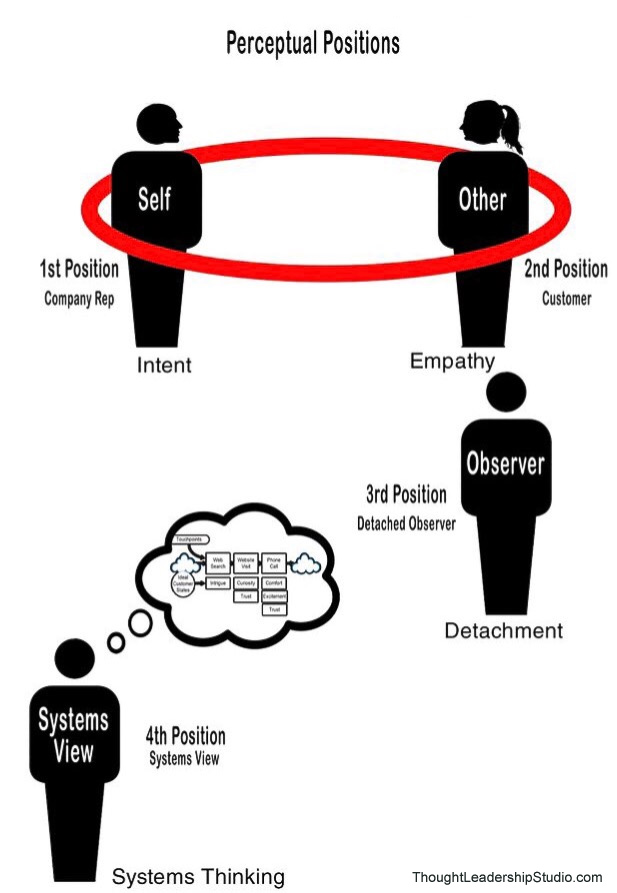Thought Leadership Studio Blog Posts:
5 Powerful Applications for NLP in Business
Do you value excellence in business? One definition of NLP (Neuro Linguistic Programming) is the study and replication of excellence. As such, it has many applications in business, particularly in Strategic Thought Leadership

#contentmarketing, #influencermarketing, #innovation, #marketingstrategy, #mentaltraining, #neurolinguisticprogramming, #nlp, #persuasion, #strategicthoughtleadership, #thoughtleadershipmarketing
NLP stands for Neuro-Linguistic Programming.
Neuro- the nervous system, our capabilities in thinking and acting.
Linguistic- the structure of language that enables us to utilize it for ...
Programming said nervous system, for overcoming obstacles, resolving problems, and creating and sustaining outstanding levels of performance,
NLP was originally developed in the 1970s by linguist Dr. John Grinder and then-student Richard Bandler. They created a language for decoding the communication skills of persuasion masters like Milton Erickson, the father of modern hypnotherapy and Fritz Perls, the founder of Gestalt Therapy. Further, Bandler and Grinder's syntax makes the formerly mysterious abilities teachable. They and other early leaders of NLP also modeled peak performers in sports, business, therapy, and science.
NLP treats the thinking patterns of high performance like computer code, enabling decoding and transferring the thinking and behavior patterns that lead to excellence in any area. The power of what Bandler and Grinder created goes deep and the applications run wide. Think Grand Canyon.
I have studied, obtained training in, and utilized NLP in both coaching and business for decades and have yet to find a comparable human performance technology. What comes closest is Sports Psychology, which I am also a fan of and which, I think, should be applied to more areas and called "Performance Psychology" instead.
I understand NLP has its critics and that is true for anything that presents a strong challenge to established paradigms. When entrenched followers who have staked their lives and careers on a model experience it getting undermined by a disruptive technology, they tend to react. I try not to hold it against them. A disrupter in another field was asked how he stays calm given the attacks on his revolutionary findings. He answered (and I paraphrase), "They are just playing their parts in the system. This is what happens when paradigms are changing." I have yet to see a relevant, valid criticism of NLP (when taught or practiced by someone credible) from a party who both understands it fully and also doesn't have something to lose by its success.
There are people who feel their models threatened by NLP, though, and their criticisms of "it doesn't work" and "it is dangerously manipulative" (hmmm) aren't hard to find on the internet. I hope they don't dissuade you from investigating it deeply enough to make your own firsthand judgment. I am very glad they didn't stop me.
Bandler in particular challenged the fields of Psychology and Psychiatry for going in (what he called) "the wrong direction" as they were focused on studying people with problems then labeling them with their definitions of dysfunctions. He pointed out that studying problems only teaches you to replicate the problems and you should instead study high achievers - as well as people who have overcome those problems - in order to decipher what they are doing that is different. He also challenged the hourly session model as creating financial incentive for keeping people under care rather than helping them change quickly, as NLP quickly proved it can do.
Additionally (and this is my take) labelling people with psychological dysfunctions creates identity-level problems and can be dysfunctional itself. As I've heard Richard say, people are simply learning machines that learn the bad along with the good because we weren't given instructions manuals for our brains. NLP can be such an instruction manual, in my experience.
Since this site, blog, and podcast is largely focused on business persuasion ....
Here, we'll look at five skills from NLP that are especially useful in business.
This is an overview to give a sense of how much there is to gain with the application of NLP in business. You can dig deeper with study and perhaps a certification course if you become intrigued enough to look into mastering these practices. Or you could hire an NLP Practitioner or NLP-trained Thought Leadership Coach to assist with evolving your business in sales, marketing, or leadership. Or you could bring in an organizational consultant with these skills:
1. Building Rapport
Great communicators develop rapport before they attempt to persuade. NLP defines rapport on several levels. Matching and pacing another's physical movements and speech gives the feeling "this person is like me." If it is just subtle enough, it can be very effective at creating comfort while going unnoticed on a conscious level. This can be as simple as holding the same posture while speaking in the same loudness and with the same rhythm as the person you are matching. Indirect matching and mirroring is less noticeable because you match one aspect of your counterpart with another .... such as moving your hand synchronized with your prospect's head motions.
Another helpful type of rapport is "criterial rapport." You create this by feeding back another's desired outcome with precision. Find out their intended result and repeat it back to confirm understanding and get agreement along with the sense of being aligned towards a common goal. You metaphorically (and maybe literally) move from across the table to the same side as them, looking in the same direction, pointing to the same future.
In Strategic Thought Leadership, we aim to gain rapport on the "higher level" of Values. Since we aim to persuade on the level of Mental Models, AKA beliefs, communicating shared values - utilizing what is most important to a prospect or audience as the basis for our intervention - enables us to do so with grace, finesse and empathy.
2. Eliciting and Anchoring Positive States
 Wouldn't it be nice to be able to call upon your highest level of motivation and focus it exactly where you want it? NLP has processes for eliciting any positive state of mind you have experienced and putting it wherever you find helpful. For example, in NLP sales training, measurable improvements in phone sales have been gained by anchoring the expectation of success to answering the phone.
Wouldn't it be nice to be able to call upon your highest level of motivation and focus it exactly where you want it? NLP has processes for eliciting any positive state of mind you have experienced and putting it wherever you find helpful. For example, in NLP sales training, measurable improvements in phone sales have been gained by anchoring the expectation of success to answering the phone.
The best sales persuasion runs two concurrent tracks: people need the logical reasons to support purchase decisions they make more on the basis on emotions. So, while connecting the logical dots for them is important, a salesperson also benefits by evoking a strong, positive emotional state and attaching it with firm anchoring to a shared vision of the enriched life the benefits of the product or service will bring.
In Strategic Thought Leadership, we want to create a state path as one form of "back-story" underpinning all of our communications with a person or audience.- What emotion is commonly connected to the "old thinking" we are leading people from?
- What new, better emotion do we want to firmly anchor to the "new thinking" of our Thought Leadership destination?
- Do we need a transition state, such as curiosity, as a mile marker along the adventure?
A back-story of an emotional journey adds great power to a message. And we can so firmly anchor a strong positive emotion to where we are leading an audience to that we become shining examples of that empowering state, fully congruent with your message with the passion great leaders exemplify. (Click here for a podcast episode on how to add emotional power to your message.)
3. Belief Change
In Systems Thinking, brought to a wider audience by Peter Senge's book The Fifth Discipline, "Mental Models" are often levers for making positive changes in companies. "Mental Models" is another name for "Belief Systems," or, in NLP, "beliefs": the assumptions we make that are the hidden foundations of our decisions.... and, perhaps, our destinies.
Beliefs are usually unconscious. Being able to uncover, examine, then change a belief underlying an underperforming business system can be extremely powerful. An example might be finding a belief that "you should always purchase the lowest bid" at the root of an unreliable product. If product reliability problems are discovered to cause returns and bad reviews that undermine profitability, then changing that belief to the more appropriate mental model that "it's better to choose vendors that add the most value to the end customer" could be a perhaps counter-intuitive leverage point that brings a leap in profitability.
NLP is rich in methods for discovering disempowering beliefs and replacing them with more empowering one.
In Strategic Thought Leadership, beliefs, AKA mental models, are a leverage point for gaining and growing an audience or creating and dominating a market niche. Impacting mental models is an example of high level influence in the sense that mental models are a higher neurological level, in NLP terms, than knowledge or skills.
Higher neurological levels impact lower levels but not so much the other way around. If someone believes they can do something, they will seek and collect the knowledge and skills needed. If someone believes they can't do something, they will block themselves even if they have the necessary knowledge and skills.
Whether you think you can, or you think you can't – you're right. - Henry Ford
When you lead an audience to a more empowering mental model about how to extract value from a product or service, or make smarter buying decisions in a category, it also gives you the opportunity to set market criteria that can only be met by your or your client's product or service. You can define - in the minds of your audience - not only a niche but an exclusive niche.
4. Multiple Perspectives
In NLP, we talk about first, second, and third positions as three different ways to perceive a situation. For example, the "first position" might be described as seeing things from the eyes of a service representative assisting a customer. The "second position," conversely, would be seeing things from the customer's point of view in the same situation (as well as hearing things from the customer's ears). Things can feel quite different from there.
Feeling what a customer feels minimizes such differences, of course, leading to more empathy: perhaps the key principle in customer-oriented businesses.
 The "third position" is taking in the situation as an uninvolved third party, watching from the distance. Different information is gathered from the third position, where the interplay can be better observed with detachment.
The "third position" is taking in the situation as an uninvolved third party, watching from the distance. Different information is gathered from the third position, where the interplay can be better observed with detachment.
And there is a further "fourth position" which is the Systems View...stepping back a different way to assess the dynamics as a system, using the tools of Systems Thinking to map feedback loops and better understand the system dynamics.
Being able to see things from the customer's point of view as well as from the detached observer and systems view perspectives brings new information that helps gain rapport and understanding. Switching positions is a also a useful skill for negotiation and resolving conflict.
In Strategic Thought Leadership, taking the second, third, and fourth positions is key for gaining the market Insight needed to discover opportunities for thought leadership.
It is challenging for us to see our businesses through the heavily filtered lenses of our typical audience member's more limited understanding of what we do. But that is essential for designing our messaging from their point of view, which is a leverage point for breakthrough marketing results.
Hence, the discipline of adopting the various perceptual positions in order to cut through the fog of the "missing the forest for the trees" effect and create the Impact on an audience we are aiming for with Strategic Thought Leadership.
5. Reframing
The ability to put a new frame around a situation can add motivational "juice" and put problems in new perspectives that lead to solutions.
An example of a reframe that changed an entire industry is when certain restaurateurs realized they were in the entertainment business and not simply in the nourishment business.
Personal Fitness Training flourished as more people saw helping people get fit through the frame of a coach rather than that of an equipment provider. I am currently working on a similar reframe in marketing, helping leaders see the benefits of working with a Thought Leadership Coach, a more leveraged role for empowering leaders in this manner than the typical agency frame. We need agencies too, but if you only address marketing through the agency frame, it can limit potential because the relationship implies (at least to some) working within clients' current mental models about how marketing is done.
Remember how mental models are a leverage point for positive change? That translates perfectly to marketing impact.
Nearly any business situation can be reframed to bring new information onstage, add a choir singing different talking points, and - speaking of restaurants - spice things up by adding new flavors to the meal of our thought leadership. And so the audience sees, hears and feels things in a new way through a different context.
Strategic Thought Leadership uses reframing as a primary strategy. We can change the game of a market niche, profession, or industry by changing the frame about how a product is used, what a service is for, or what criteria is really important in assessing a practitioner of a particular profession, to list a few examples.
**********
NLP has proven to be a powerful tool in sales and business leadership, enabling and creating more aligned teams with higher motivation, uncovering the source of and solving business problems, and shedding light on new, innovative perspectives.
I have personally found NLP to be an extraordinary tool in Strategic Thought Leadership, along with Systems Thinking, Game Theory, and Mythic (AKA Jungian) Archetypes. NLP has been powerful for determining the essential components of the structure of successful thought leadership, coaching and training thought leaders and thought leading organizations, and in creating powerful campaigns that move the thinking of a marketplace.
***************************************